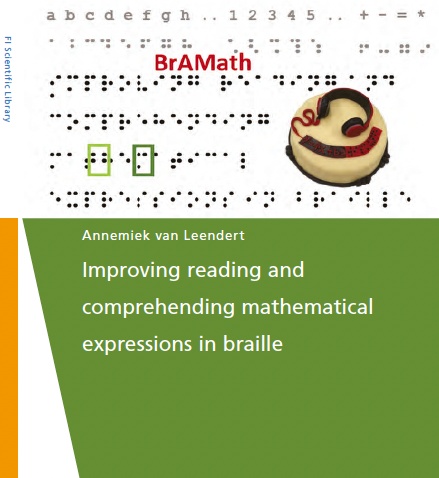Improving reading and comprehending mathematical expression in braille

|
Proefschrift Annemiek van Leendert, Universiteit Utrecht
Improving reading and comprehending mathematical expression in braille |
De verdediging vindt plaats in een hybride vorm. Conform de richtlijnen, kunnen er momenteel 80 mensen in de Academiezaal aanwezig zijn.
The main research question guiding this study is: How can braille readers improve reading and comprehending of mathematical expressions? We have studied that question from different perspectives. The emphasis was on research into tactile perception, professionalization of mathematics teachers and representing mathematical expressions in braille.
Braille readers read expressions by moving their fingertips over the braille characters. We have gained a lot of insight into this with the help of finger tracking technology. The results show that braille readers have developed their own ‘reading strategies’, making little use of the mathematical structure of expressions. Therefore, we developed an intervention teaching braille readers to use finger movements that focus on the structure of the expressions. As a result, they picked up on the features of the mathematical structure more quickly. We then gave a professionalization course to mathematics teachers of braille readers. Tactile and auditory perception played a crucial role in this course. The results show that teaching mathematics to braille readers is not just a matter of translating teaching materials into braille. Reading in braille also has repercussions for teaching and learning mathematics. Finally, we examined mathematical braille notations in various countries. The results show that the expressions are usually represented in such a way that they support the braille readers themselves in obtaining a mathematical overview, or that they support communication between braille readers and readers who do not use braille.
De centrale vraag in dit onderzoek is: Hoe kunnen braillelezers het lezen en begrijpen van wiskundige expressies verbeteren? We hebben deze vraag vanuit verschillende invalshoeken benaderd. De nadruk lag op onderzoek naar tactiele waarneming, professionalisering van wiskundeleraren en het weergeven van wiskundige expressies in braille.
Braillelezers lezen expressies door hun vingertoppen over de braillekarakters te verplaatsen. We hebben hier met behulp van finger tracking technologie veel inzicht in gekregen. De resultaten laten zien dat de braillelezers eigen ‘leesstrategieën’ hebben ontwikkeld en daarbij weinig gebruik maken van de wiskundige structuur van expressies. Daarom hebben we een interventie ontwikkeld die braillelezers leert om vingerbewegingen te gebruiken die gericht zijn op de structuur van de expressies. Het resultaat was dat ze de kenmerken van de wiskundige structuur sneller oppakten. Vervolgens hebben we een professionaliseringscursus gegeven aan wiskundedocenten van braillelezers. Tactiele en auditieve waarneming stonden hierbij centraal. De resultaten laten zien dat het geven van wiskunde aan braillelezers niet alleen een kwestie is van het omzetten van lesmateriaal in braille. Het lezen in braille heeft ook gevolgen voor het lesgeven en het leren van wiskunde. Tenslotte hebben we de wiskundige braillenotaties in diverse landen onderzocht. De resultaten laten zien dat de expressies meestal zo worden weergeven dat ze de braillelezers zelf ondersteunen bij het verkrijgen van wiskundig overzicht, óf de communicatie tussen braillelezers en lezers die geen braille gebruiken ondersteunen.
- Hoofdstuk 1. – Introduction
- Hoofdstuk 2. – An Exploratory Study of Reading Mathematical Expressions by Braille Readers
Dit hoofdstuk is interessant voor diegenen die betrokken zijn bij tactiele waarneming en onderzoekt hoe studenten dit doen, vaak op verrassende manieren. - Hoofdstuk 3. – An Exploratory Study to Improve Reading and Comprehending Mathematical Expressions in Braille
Dit hoofdstuk beoordeelt hoe de tactiele waarneming kan worden verbeterd en sluit nauw aan bij wiskundige structuren. - Hoofdstuk 4. – Teachers’ Skills and Knowledge in Mathematics Education for Braille Readers
Dit hoofdstuk beschrijft het effect van een professionele ontwikkelingscursus die werd geleid door het bekende TPACK-model op docenten. - Hoofdstuk 5. – Supporting Braille Readers in Mathematical Practices Using the Braille Display in Coordination with the Speech Synthesizer
Dit hoofdstuk heeft ook betrekking op de eerder genoemde cursus professionele ontwikkeling en beschrijft het effect van deze cursus op braillelezers. - Hoofdstuk 6. – Towards a Universal Mathematical Braille Notation
Dit hoofdstuk gaat over representaties in braille; degene die betrokken zijn bij het gebruik van grafische rekenmachines hebben hier mogelijk een link mee. - Hoofdstuk 7. – Conclusion and Discussion
Verwijzingen
- Van Leendert, A. J. M., Doorman, L. M., Drijvers, P. H. M., Pel, J. and van der Steen, J. (2019). An exploratory study of reading mathematical expressions by braille readers Journal of Visual Impairment and Blindness, 113(1), 68–80. 10.1177/0145482X18822024
- Van Leendert, A., Boonstra L. G., Doorman, M., Drijvers, P., van der Steen, J., & Pel. J. (2021). An Exploratory Study to Improve Reading and Comprehending Mathematical Expressions in Braille. British Journal of Visual Impairment. https://doi.org/10.1177/02646196211044972.
- Van Leendert, A.J.M., Doorman, L.M., Drijvers, P.H.M., Pel, J., & van der Steen, J. (2019). An exploratory study of reading mathematical expressions by Braille Readers. Journal of Visual Impairment and Blindness, 113(1), 68–80. https://doi.org/10.1177/0145482X18822024
- Van Leendert, A-M., Doorman, L. M., Drijvers, P., Pel, J., & van der Steen, J. (2019). Supporting braille readers in reading and comprehending mathematical expressions and equations. In U.T. Jankvist, M. van den Heuvel-Panhuizen, & M. Veldhuis (Eds.), Proceedings of the Eleventh Congress of the European Society for Research in Mathematics Education (pp. 4704–4711). Freudenthal Group & Freudenthal Institute, Utrecht University and ERME. https://dspace.library.uu.nl/bitstream/handle/1874/3.9215.5/Supporting_braille_readers.pdf?sequence=1
- Van Leendert, A., Doorman, M., Drijvers, P., Pel, J., & van der Steen, J. (2021). Teachers’ skills and knowledge in mathematics education for braille readers. Technology, Knowledge and Learning. https://doi.org/10.1007/s10758-021-09525-2
- Van Leendert, A.J.M., Doorman, L.M., Drijvers, P.H.M., Pel, J. & van der Steen J. (2021). Supporting braille readers in mathematical practices using the braille display in coordination with the speech synthesizer. Journal of the International Association of Special Education, 20(1), 20–31.
- Van Leendert, A.J.M., Doorman, L.M. Drijvers, P.H.M. Pel, J., & Van der Steen, J. (in press). Towards a Universal Mathematical Braille Notation. Journal of Visual Impairment and Blindness.
Professional publication
- Van Leendert, A. J. M., & Doorman, L. M. (2016). Het FIzier gericht op wiskundige expressies voor braille-afhankelijke leerlingen. Euclides, 91(7). https://dspace.library.uu.nl/bitstream/handle/1874/343169/Het_fizier_gericht_op_.._wiskundige _expressies_voor_braille_afhankelijke_leerlingen.pdf?sequence=1



